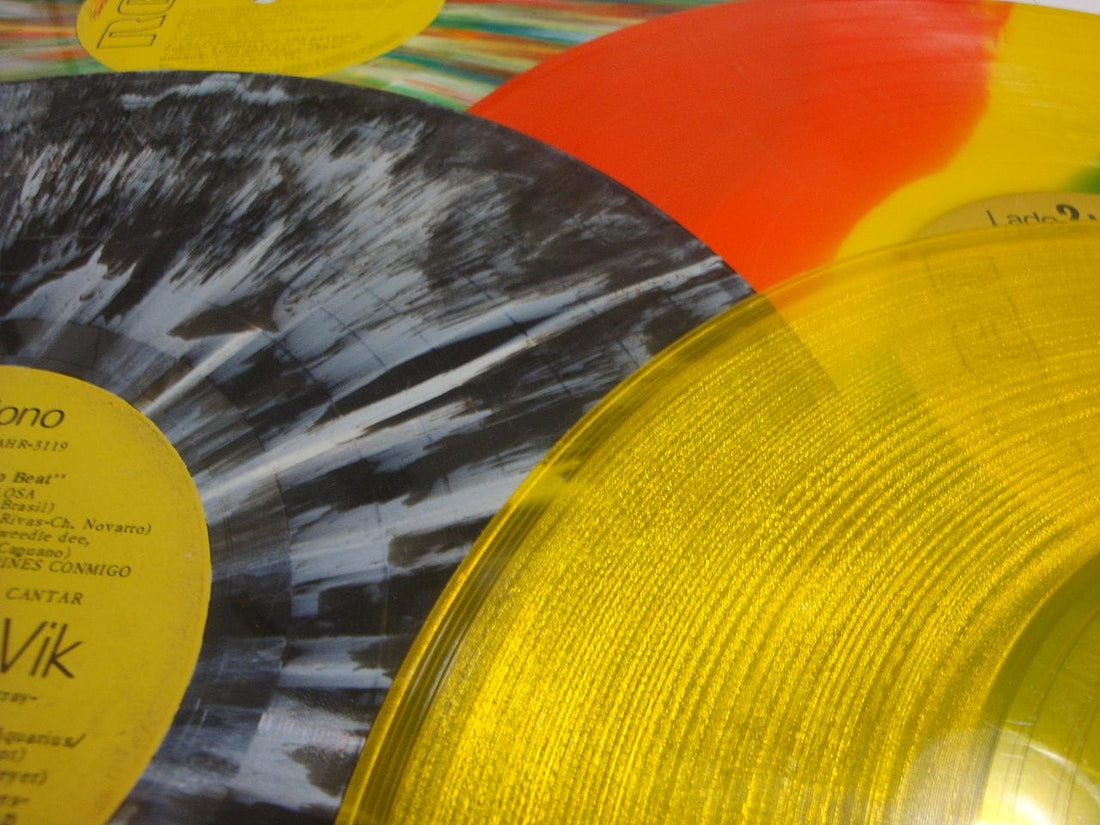Records, from the age of shellac to the vinyl era, have traditionally been black. Artwork was typically confined to the small round paper label on the record itself and to the packaging.
Unsurprisingly, when a record deviates from the plain black object we are all used to, it draws attention. Colored records, transparent records, splatter disks, translucent records and picture disks can look stunning and boost sales. But how do they actually sound?
To answer this question, we should begin by investigating how these records are manufactured. The raw material, a polyvinyl chloride (PVC) blend that contains certain additives to improve performance, arrives at the pressing plant in large sacks containing granules. Typically, these granules are already black, manufactured as such by the polymer supplier. To produce a black record, these granules are placed in a large hopper, which feeds them to an extruder, which melts and squeezes them into a homogenous dough-like form, shaping them into soft round pucks of a predetermined weight. Each hot puck is then placed between the molds of a hydraulic press and a record is pressed. Since the granules and puck are black, the final record is also black.

This would therefore be the reference with which all fancier-looking records will be compared.
Making a transparent record is a very similar process, the difference being that the PVC granules used are not the typical black ones, but transparent granules ordered from the polymer supplier. This is a different blend, and contains different additives. The homogeneity of the blend is similar, but in practice transparent records, more often than not, suffer from static a lot more than black records. Also, most pressing plants go through many more sacks of black granules than transparent granules each year, so the requirements and controls for the black granules are usually much stricter.
Making colored records introduces an additional step. Since each customer is likely to request a different color or combination of colors, it doesn’t make much sense for a pressing plant to stock all possible colors of granules. So, they use transparent granules mixed with pigment powders to create the desired color. The discrete pigment particles are unfortunately traced by the playback stylus, increasing the background noise of pigmented records.
Splatter records and multi-color disks, including marbled, striped, polka-dot and any other variants are even more complicated requiring multiple pigmentation stages to mix and match colors and shapes. As the playback stylus moves from one color to the next, the minute changes in the microstructure of the material create changes in the character of the noise floor, rendering it much more noticeable than a continuous noise floor.
Picture disks are very similar to transparent records. They are actually two halves of a transparent record, with a printed picture in between. The sandwich is permanently sealed together. While the surface of the record is the same as a transparent record, the picture sandwich construction does seem to introduce a resonant element and picture disks sound noticeably different to plain transparent or black records pressed from the same stampers.

While all of the aforementioned colorful and creative variations are great to look at, the tradeoff is unfortunately that what is good for the looks is not best for the sound.
But how bad is it?
Not that bad actually, if a few important points are taken into account. The mastering and plating processes for colorful records are exactly the same as for black records. The mastering stage, where the lacquer master disks are cut, is always the most critical part of the process, defining the sound of the final product to a much greater extent than any other aspect of disk manufacturing. As such, starting out with great mastering, as is true for black records, greatly improves the chances that the final product will sound good. Bad masters cannot be made to sound good, no matter what is done in subsequent stages.
But even if we begin our sonic journey with excellent masters, not all plating and pressing is equal. Even assuming that the plating is accomplished with due care, there is still the pressing stage that can make or break the final product.
Just as with black records, colorful records require a lot of skill, craftsmanship, attention to detail and heavy industrial equipment in good working order. A good pressing plant will routinely achieve much quieter colored records than a mediocre plant, even if both facilities can make records that look just as pretty. In practice, the more complex and elaborate types of colorful records require more skill and more equipment, so a better pressing plant can usually also make prettier records that also sound impressively good. In fact, the colorful records of a good pressing plant can often sound much better than the black records of a mediocre plant.

Most of the “issues” inherent in colorful records are related to an increase in the noise floor, compared to black records. While this increase can be kept quite small by competent plants, it is still there. As such, colored records are a better match for music and recordings with less intense dynamics, to keep the distance between the music and the noise floor of the medium as great as possible. Ideal candidates are usually rock, pop and some electronic music albums.
On the other hand, a lot of the classical and jazz repertoire is very dynamic, calling for the widest signal to noise ratio that can be achieved, in which case, black records are perhaps more appropriate.
In the final analysis, in the case of a popular music recording with intentionally limited dynamics, the difference in sound quality between a good black record and a good colorful record would most probably remain inaudible to the majority of listeners.
Header image courtesy of Wikimedia Commons/Banfield.


